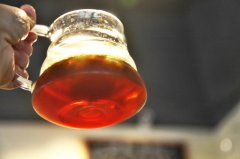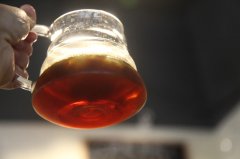What are the taste and characteristics of the washing of Hailera Manor in Antioquia, Colombia?

Professional coffee knowledge exchange more coffee bean information please follow the coffee workshop (Wechat official account cafe_style)
What are the taste and characteristics of the washing of Hailera Manor in Antioquia, Colombia?
Variety: Caturra Kaddura species
Production area: Columbia Antioquia Antioquia, Colombia
Management: Washed traditional washing treatment
Grade: SHB extra hard beans
Altitude: 1800 m
Manor: La Herrera Herrera Manor
Flavor description:
Light flowers, white grape juice, sweet honey, cream, fruit fudge, sweet orange notes, smooth taste and thick sweetness
In recent years, the "Best Cup" series has been organized by Colombian exporter Banexport and American bean manufacturer Cafe Imports in several major Colombian producing areas (Cauca, Antioquia, Huila, etc.), so that small farms that do not produce enough to participate in C.o.E can also be in direct contact with buyers. First, samples of raw coffee beans are collected by Banexport, and then tested by buyers' cups around the world for finals and auctions. The final bid price of the champion batch is also very high. In addition to allowing producers to receive income directly according to quality, such competitions also enhance the diversity of coffee quality through such activities.
Antioquia's Best Cup is an event sponsored by the local government to showcase the best coffee in the region. The event is a symbol of Antioquia's efforts to educate citizens, reduce violence and promote economic prosperity. In the best cup test competition, coffee buyers from all over the world are invited to taste 60 varieties of Antioquian coffee in the form of cup test and bid at auction. The highest bidder has a chance to meet the coffee producer.
Western Colombia is the Andes, divided into three parts: the western, central and eastern mountains. The main producing areas are Huila (San Augustin), Narino, Tolima, Popayan (Cauca), Valle de Cauca, Meta, Antioquia (Medellin), Magdelena (Sierra Nevada), Boyaca, Santander (Bucaramanga) and so on.
Of the coffee trees grown in Colombia, 66% are grown in modern plantations and the rest in small, traditionally run farms. The main varieties include Kaddura Caturra, Colombian Colombia, Tibica Tipica, bourbon Bourbon, elephant bean Maragogype, and Tabi. Farms and cooperatives across the country, large and small, run by more than 500000 farmers, are distributed in the country's 590 municipalities and 14 major coffee-producing areas, with a total of 2 million Colombians dependent on coffee cultivation for their livelihood.
Antioquia, located in north-central Colombia, grows 126000 hectares of coffee and produces 2000000 bags of coffee beans, accounting for 18% of Colombia's output, second only to Huila.
Most of the province is alpine terrain belonging to the Andes, but it is blown by the warm Caribbean sea breeze. Medellin Medellin, the provincial capital, is the second largest city in Colombia, and it is also an important coffee producing area in Colombia. There are many small farmers in this producing area, and the fine coffee beans produced in micro batches are full of flavor in the producing area. In recent years, with the attention to the quality of coffee and the demand for fine coffee in the international market, the production of micro-producing areas arises at the historic moment, and small-scale coffee farmers are organized to provide micro-batches mainly Micro-Regional Selections, and dozens of small farmers provide their unit harvest to be integrated into a micro-batch to sell. Quality control will be better, so they will have the opportunity to select many high-quality small-scale farmers' coffee in specific micro-producing areas through each batch cup test. Its coffee flavor is more lively, with fresh aromas of ripe fruit and caramel, and the combination of sour taste and sweet taste is well balanced.
Important Notice :
前街咖啡 FrontStreet Coffee has moved to new addredd:
FrontStreet Coffee Address: 315,Donghua East Road,GuangZhou
Tel:020 38364473
- Prev

Introduction to Farm Introduction, Vesta Beauty Manor, the Story of Coffee production in Koban, Guatemala
Professional coffee knowledge exchange more coffee bean information please follow the coffee workshop (Wechat official account cafe_style) Vista Beauty Manor Kaddura Kaduai washing treatment method Farm Location Manor location Farm Introduction Manor introduction Vista Beauty Manor is one of the first farms in the Koban production area, German immigrants reclaimed here, at the same time for melons
- Next

The story of the Acatenango producing area of Akat Nango, Guatemala. Orange honey coffee style at St. Felicia Manor.
Professional coffee knowledge exchange more coffee bean information please follow the coffee workshop (Wechat official account cafe_style) Kaduai is a hybrid of bourbon and Tibica, the bean body is slightly larger than the original bourbon. Let's start with honey treatment. Honey treatment is to mechanically remove part of the pulp of the coffee cherry and then ferment it in the sun. Different from the sun.
Related
- Detailed explanation of Jadeite planting Land in Panamanian Jadeite Manor introduction to the grading system of Jadeite competitive bidding, Red bid, Green bid and Rose Summer
- Story of Coffee planting in Brenka region of Costa Rica Stonehenge Manor anaerobic heavy honey treatment of flavor mouth
- What's on the barrel of Blue Mountain Coffee beans?
- Can American coffee also pull flowers? How to use hot American style to pull out a good-looking pattern?
- Can you make a cold extract with coffee beans? What is the right proportion for cold-extracted coffee formula?
- Indonesian PWN Gold Mandrine Coffee Origin Features Flavor How to Chong? Mandolin coffee is American.
- A brief introduction to the flavor characteristics of Brazilian yellow bourbon coffee beans
- What is the effect of different water quality on the flavor of cold-extracted coffee? What kind of water is best for brewing coffee?
- Why do you think of Rose Summer whenever you mention Panamanian coffee?
- Introduction to the characteristics of authentic blue mountain coffee bean producing areas? What is the CIB Coffee Authority in Jamaica?

